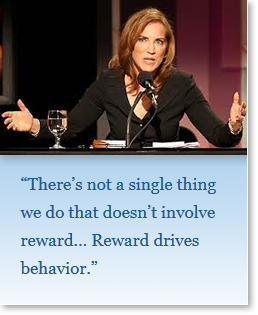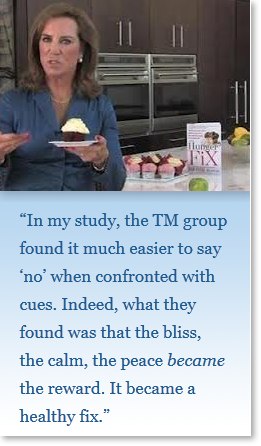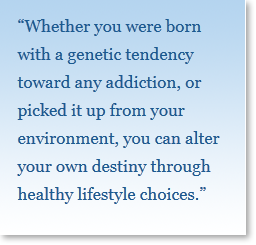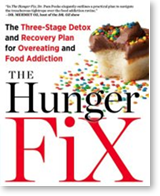 Pam Peeke, MD, MPH, FACP, is the New York Times bestselling author of Body-for-Life for Women, Fight Fat after Forty, and Fit to Live. Dr. Peeke is a Pew Scholar in nutrition and metabolism, assistant clinical professor of medicine at the University of Maryland, Fellow of the American College of Physicians, and a nationally recognized expert in nutrition, fitness, and public health. She is WebMD’s lifestyle expert, host of Discovery Health Channel’s Could You Survive series, and spokesperson for the American College of Sports Medicine’s Exercise is Medicine global initiative.
Pam Peeke, MD, MPH, FACP, is the New York Times bestselling author of Body-for-Life for Women, Fight Fat after Forty, and Fit to Live. Dr. Peeke is a Pew Scholar in nutrition and metabolism, assistant clinical professor of medicine at the University of Maryland, Fellow of the American College of Physicians, and a nationally recognized expert in nutrition, fitness, and public health. She is WebMD’s lifestyle expert, host of Discovery Health Channel’s Could You Survive series, and spokesperson for the American College of Sports Medicine’s Exercise is Medicine global initiative.
Her latest book, The Hunger Fix: The Three-Stage Detox and Recovery Plan for Overeating and Food Addiction (Rodale), a New York Times bestseller launched on The Katie Couric show, explores the new brain science behind food addiction—offering a step-by-step detox and recovery plan to rewire the brain for healthy eating. Here she talks about the value of the Transcendental Meditation technique in strengthening the prefrontal cortex to overcome food addiction, a topic she also addresses in her book.
Q: What motivated you to write The Hunger Fix?
Dr. Peeke:
For years I have listened to my patients referring to their eating problems using a drug vernacular. “I need another hit,” they would say, “Withdrawal is killing me,” or “I need to score some more.” In the back of my mind and that of my colleagues, I wondered if there was an addiction going on here.
At that time we had some compelling science that suggested a food and addiction link. But I needed more. I waited somewhat impatiently until there was a critical mass of data from neuroscientists and then wrote the book to translate this groundbreaking information for people in a way that can help them.
The first chunk of new science presented in the book—based on NIH research by Dr. Nora Volkow, Director of the National Institute of Drug Abuse, and others—is a real game-changer: Food addiction is real. For that matter, at the Weight of the Nation conference in Washington, D.C., last May, Kathleen Sebelius, Secretary of Health and Human Services, stated in her keynote address, “Obesity can be caused by any combination of factors. For some it’s an addiction like smoking.” That was a first from such a high-ranking government official.
The Hunger Fix is a game-changer. No longer will people be foisted into a one-size-fits-all approach to weight management and wellbeing. Instead, we have now discovered a new category of folks, those with an issue with food and addiction, who need a more customized and individualized approach to their problem.
Q: How does something as natural and necessary as food become addicting?
Dr. Peeke:
There’s not a single thing we do that doesn’t involve reward. Some rewards are obvious, like “Let’s go look at this beautiful sunset.” Another obvious reward is the bliss I feel when I do TM. Reward drives behavior. And if we didn’t have certain rewards, such as sex and food, we wouldn’t be here today. To survive, we have to procreate and we have to eat.
Food is meant to be palatable, rewarding, and pleasurable. We love the smoothness of fat, and consuming it helps us survive in times of famine. That primal reward and survival system has been working beautifully for thousands of years.
Then something happened: we changed up the food supply. Food companies wanted to provide products for a mass population, and in order to do that, they manufactured, refined, and processed foods—and in doing so got further and further away from whole foods. What then appeared on shelves were so many what I call “science fair projects,” food-like products that contained chemicals and preservatives to keep food shelf-stable. Most importantly, these products were also loaded with added sugar, fat, and salt—the “hyperpalatables”—to increase the reward and pleasure derived from consuming them.
We all love treats—my grandmother made some killer oatmeal-raisin cookies that to this day I can still taste. It was a special occasion when she went to all the trouble to make them from scratch. I wasn’t drowning in these cookies 24/7. A treat is meant to be consumed occasionally and thoroughly savored and enjoyed. And they weren’t overly sweet or covered in glaze and goo. They were just plain old oatmeal cookies, but they were considered a treat.
In the reward center of the brain, the pleasure-reward neurotransmitter, dopamine, was secreted when I ate that first oatmeal cookie. And once you taste the waters, you never forget them. So when my grandmother would say she was coming over with oatmeal cookies, I didn’t even have to eat them. The cue alone—knowing that that oatmeal cookie was on its way over to me—was all I needed. My reward center lit up like Kyoto at night. Research now shows that it’s actually the cue, not the consumption, that produces the highest levels of dopamine. The very anticipation is what lights up our reward center.
Now what if I added more fat, more sugar, as in a Ho-Ho or a Hostess Cupcake? After I taste it, it is seen by my brain as hyperpalatable—that combination of super-sugary, super-starchy, or super-salty—way over my poor little grandmother’s oatmeal cookies. My reward center has been hijacked by these uber-palatable food products.
My brain can handle having a nice treat with controlled combinations of sugar and fat once a week. But what if these hyperpalatable treats are now available 24/7, and are so ubiquitous and cheap that they’re accessible to everyone at every economic level? In some people, repeated exposure to these foods results in a feeling of being out of control, often leading to overeating and sometimes binging. I refer everyone to the newly developed Yale Food Addiction Scale to examine their own relationship between food and addiction. I would wager that most people of all sizes have some issue due to the environment within which we live and work.
All right, so going back to my brain. What happens if I’m overexposed to these hyperpalatables?
The answer is that this overexposure results in organic changes in your brain—the exact changes that happen with any addiction. First of all, the brain can’t handle the tsunami of dopamine. Overstimulated and organically destabilized, the primal survival mechanism protecting you from this wave of dopamine results in a downregulation (decrease in the number of dopamine receptors) so that you cannot perceive the overstimulation. You’ll then feel some reward but not the over-the-top levels.
That’s the good news.
Here’s the bad news. By reducing the total number of dopamine receptors, you experience much less pleasure and reward when you actually consume these hyperpalatables. This drives you to reach for more and more to quench that thirst for the “high” you normally got from that food. But it becomes the itch you just can’t scratch. You need more and cannot derive the level of reward you’re desperately seeking. Thus begins the classic vicious cycle of addiction to anything, whether it be food, drugs, or alcohol.
Q: What is the role of the prefrontal cortex (PFC) in addiction?
Dr. Peeke:
The prefrontal cortex (PFC) is the chief executive officer (CEO) of the brain—the part of the brain that reins in addiction’s three I’s: impatience, irritability, and impulsivity. NIH’s Dr. Volkow also refers to the PFC as the “brain’s brake” because it helps us say “no” when we need to and maintains vigilance to keep us on track with healthy lifestyle choices. It helps us exert will power, as well as “won’t” power, as we strive to say “yes” or “no” to lifestyle choices.
In people with addictions, the PFC is damaged and impaired. This has been noted in fMRI and PET scan studies in which we can clearly see the deactivation of the PFC and orbitofrontal areas of the brain when someone is in a full-out active addictive state. The revolutionary studies performed by neuroscientists like Gene-Jack Wang at the Brookhaven National Laboratory have laid down the foundation for understanding how any addiction, including that to food, affects the PFC.
So when the CEO of the brain is impaired by addiction, moderation is a moot point. You cannot ask someone to implement moderation when they are in an active addictive state. With an impaired PFC, the correct decisions cannot be made. It’s important to note here that knowing you may have an issue with food and addiction is not an excuse not to do anything. On the contrary, enlightened with this new knowledge, you must take action to get off the bingeable hyperpalatables that lead to loss of control—and to learn how to live lifelong recovery without them.
If your reward center has been hijacked, the solution is to reclaim your brain by using your brain, specifically, the PFC. It’s imperative that through the detox and recovery program, you strengthen and actually grow a smarter brain to help guide you and maintain that all-important daily vigilance.
This is, as with all addictions, a challenge. Food addiction is more challenging than other addictions because we live in a virtual mine field of cues to eat the hyperpalatables. This is why it’s so important to power up your PFC.
Q: How do you do that?
Dr. Peeke:
The main thing we do to augment PFC function is meditation. When I read about the TM technique in my friend Norman Rosenthal’s book, Transcendence, I was amazed by the research.
Because no one had looked at food addiction before, I did a couple of pilot projects, using people with food addictions as subjects. I found that TM practice had a profound influence on the ability to maintain vigilance and calm. It also helped people do the one thing that is so difficult in addiction—to adapt to life’s stresses without resorting to self-destruction. People with addictive tendencies have trouble adapting to life’s stresses without defaulting to their addiction.
TM helps them stay on track by augmenting the PFC. People have to face food cues and temptation every single day, and with TM, we’re giving them a powerful mental tool. Unless you live a Thoreau-like existence, cues abound, and you have to have the most powerful brain possible to get through. Neuroscientists have noted activation of the PFC during TM practice and a dampening of the fight-and-flight response in the brain. This is solid science demonstrating the powerful effect of TM on PFC function.
You cannot do this without meditation. I’ve made that extremely clear in my book. In my study, the TM group found it much easier to say “no” when confronted with cues. Indeed, what they found was that the bliss, the calm, the peace became the reward. They were doing a switch-off from false fixes (the hyperpalatables) to healthy fixes.
They also came to realize that meditation had to become an integral piece of their life—not a little extra attraction when they thought it was a good idea. And when they did it regularly, when their PFC became more optimized, their ability to rein in impulsivity and to remain focused was greatly enhanced. It just made it easier for them all the way around.
Q: In your book you talk about the three pillars of the hunger fix: mind, mouth, and muscle. What about the other two—mouth and muscle?
Dr. Peeke:
The book teaches you how to do direct battle with the hyperpalatables. You have to go through a little withdrawal, but we make it so easy to kill the carb cravings by eating protein-fiber combinations, by eating every three to four hours, and by using recipes that make whole foods taste as good as the hyperpalatables. In a way our nutritional program, which highlights dopamine-building foods, acts a bit like methadone—helping people gently detox off their false fixes and transition to the healthy fixes.
As for the “muscle” part, we present extraordinary data that when you are physically active—forget the Olympics here, I’m talking about assuming the vertical and walking every day—you actually induce neurogenesis (growing more brain cells and new pathways) while dampening down and sometimes shutting off high-risk genes. Regular activity, for example, deactivates the most powerful gene for obesity, the FTO gene, by 40 percent. So you’re not condemned to a life of obesity and the metabolic syndrome. You’re growing a bigger, smarter, more focused brain while improving body health and wellbeing.
That’s also why one of my book’s mottos is Big Brain, Small Waist. The sharper your PFC, the smarter your decision making.
Q: Is “dampening the FTO gene” epigenetics?
Dr. Peeke:
Yes. My entire plan in The Hunger Fix is based upon epigenetics. To put it simply, epigenetics is a brand-new scientific field that’s probably going to be the biggest game-changer of the century. It game-changes because we thought DNA was our destiny—but we were dead wrong. Now we know that it doesn’t matter what DNA you were born with—you can dramatically alter it with your lifestyle choices. Whether you were born with a genetic tendency toward any addiction, or picked it up from your environment, you can alter your own destiny through healthy lifestyle choices. DNA is no longer destiny. Every lifestyle choice you make is. That’s the essence of epigenetics.
Scientists have now identified how your genes can “talk” (that’s called genetic expression) to the rest of the body differently. To be able to give out directions to build a bigger brain. To be able to induce neurogenesis, which is the creation of more brain cells. To be able to create more neuropathways and circuitry. To be able to supervene over the old, addictive neurocircuitry.
By changing lifestyle habits—mind, mouth, and muscle—you’re able to imprint on your epigenome, which is then expressed to the rest of your body and results in these extraordinary changes, which are then passed to your children. That’s how powerful this is. Your children inherit your lifestyle.
I’m not saying you can wipe out the fact that you are genetically predisposed to heart disease, but what you can do is dampen that gene. It’s never gone, but following this plan will help you live longer.
Q: As a physician and leader in the field of healthy living, would you recommend the TM technique to everyone, even those without food disorders?
Dr. Peeke:
Absolutely—you want to build a strong foundation for the most powerful brain possible. The smarter you are, the more vigilant you are, the better your decisions, and the better your body composition, and the more optimal your health and wellbeing.
I don’t care what your weight is, you’re going to be healthier and make better choices for yourself. I would recommend TM to anyone of any age so they can gift themselves with that transcendence, with that cerebral integration, with more optimal brain functioning. And with the ability to be rewarded with the bliss, the calm, the expansion of the mind that you experience when you do TM. That’s the healthiest fix of all because that will help direct you to the other healthy fixes.
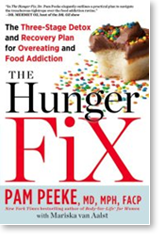
To purchase a copy of The Hunger Fix: The Three-Stage Detox and Recovery Plan for Overeating and Food Addiction
CLICK HERE.
_____________________________________________________________

This interview is reprinted from Enlightenment, the online TM Magazine
_____________________________________________________________




